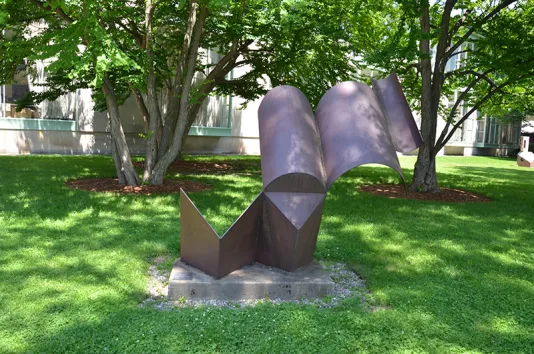Isaac Witkin, Angola, 1968. Gift of a Member of the Council for the Arts at MIT
Angola, 1968

Early in his career, Isaac Witkin grew dismissive of the passionate, emotional surfaces of the older generation of British sculptors whose work he saw as an expression of “post-war angst.”
With Anthony Caro and other sculptors of his generation, Witkin rejected the figure as a necessary basis for sculpture and began to explore a more abstract language. His sculptures of the early 1960s were made of wood, but he came to feel that the material’s grain and color variations predetermined his sculptural forms. He soon turned to fiberglass—impersonal, passive, neutral—and then to sheet steel, the medium in which he continued to work.
Angola was installed at MIT in 1978, and is part of an edition of three sculptures based on another sculpture of the same title made in 1966. The form comprises several hollow segments: two adjacent triangular prisms stand on end in contact with the ground and support two bulging half-cylinders attached to a smaller, inverted version of the same form. The overall composition, while abstract, is evocative of a mountain range below rounded clouds. This sculpture differs from the earlier version only in its addition of the smaller, concave half-cylinder along the right edge and the application of dark brown paint over the metal. In Angola, Witkin sought to imply but not define volumes and to achieve mass by means that are not massive. The metal planes slice, enfold, and mold space; the emphasis, as Witkin notes, is “on a feeling of carved space.” The title could refer to the flag of Angola, which features the central symbols of half of a round gear and a scythe, evoked here through the half-cylinders and the concept of cutting through space.
Isaac Wikin (1936–2006) was born in Johannesburg, South Africa, and emigrated to England in 1956, leaving behind the politically repressive apartheid regime. He studied in the sculpture department of Saint Martin’s School of Art, where he was influenced by sculptor Anthony Caro. After graduating in 1960, he became an apprentice to Henry Moore. In 1963, he returned to Saint Martin’s sculpture department as a faculty member. During this time, Witkin emerged among the New Generation sculptors who garnered interest in British art in the mid-1960s. His brightly colored wood and fiberglass sculptures were admired for their Pop sensibility and wit.
After relocating to the United States to become artist-in-residence at Bennington College, Vermont, in 1965, Witkin explored welded steel and exhibited his works frequently in New York. In the late 1970s, he began to move from hard-edged steel to bronze biomorphic shapes, following the earlier inspiration of Henry Moore. Witkin participated in prominent exhibitions at the Whitechapel Art Gallery, London; Jewish Museum, New York; and Hirshhorn Museum, Washington, D.C.; among others. His sculptures are in the collections of the Art Council of Great Britain; Tate Gallery, London; San Francisco Museum of Modern Art; Storm King Art Center, New Windsor, NY; and Smithsonian American Art Museum, Washington, D.C. In 1965, he received a first prize at the Paris Biennale, and in 1981, he was awarded a fellowship from the John Simon Guggenheim Memorial Foundation.